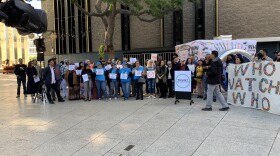Americans could be in for a long, hot summer of protests against the Trump administration over issues that include proposed cuts to safety net programs and university funding, mass deportations and the effort to end birthright citizenship.
Amid President Trump’s threat to deploy more troops to American cities after a court win, do protests still work as drivers of change?
With half the year over, it may still be too early to say. Activists argue that the authoritarian leanings of Trump’s actions make peacefulness in protest even more crucial, that nonviolence is the most effective way to reach social change.
The city of San Diego is coming off the heels of a large "No Kings" protest on June 14 to rally against what is perceived as Trump’s slide toward authoritarianism. It was part of a series of demonstrations in over 2,100 cities across the country that drew more than 5 million people.
The San Diego event had all the ingredients of a successful protest. It had a purpose. It drew big crowds. Eighty thousand people attended, the largest in the city’s history. It was diverse. Veterans, families, politicians and civil rights groups participated. And while effective civil disobedience sometimes can and does lead to physical clashes, these protests were peaceful.
Wendy Gelernter of Take Action San Diego, which focuses on electing progressive candidates, was one of the organizers of the June 14 protest.
Gelernter said the protest’s success and the organizers intent to self-regulate potential clashes was not by chance.
“Not only did we train our own people in de-escalation and have a special group of volunteer peacekeepers, who were wearing yellow vests and circulating through the crowd, we had legal advisers, again all volunteers,” Gelernter said.
“We also spent several weeks coordinating with San Diego law enforcement about their recommendations on making things as safe as possible. And they listened to us as well. It was a very positive interaction.”
She added that protests alone are futile unless people commit to other kinds of political activism, such as coalition-building, campaigning for preferred candidates and contacting elected officials when they oppose a policy.
The biggest impediment to effective demonstrations is violence.
The protesters against the ICE raids in Los Angeles earlier this month mobilized quickly in response to what they saw in their communities. This meant less time to organize and plan how to protest. And violence — though not at the level that Gov. Newsom said local law enforcement couldn’t handle — erupted in the city.
In fact, the Ninth Circuit Court of Appeals in its ruling to allow Trump’s authority over the National Guard deployment in Los Angeles for now, said its decision stemmed from a group of protesters who tried to block ICE agents from their operation June 6 by throwing concrete chunks, bottles of liquid and other objects at agents. The legal fight on the deployment is ongoing.
Former San Diego U.S. Attorney Carol Lam said military deployments to protests can serve as a kindling.
“When you have an escalation, it is a race to a bad place,” Lam said. “Then when you start arresting people and prosecuting them for engaging in protests, now you’re teetering on the edge of a real abyss.
“And in the past, we've done everything that we can do to avoid getting to that point,” she said. "Here, it's almost like the president, and those who answer to him are looking for a fight.”
In the short-term, the effect of the military deployment in Los Angeles doesn’t appear to have had a huge impact. The "No Kings" protests happened in the days after troops were sent in and they were mostly peaceful. But San Diego Congressman Mike Levin (D-49th District) said earlier this month that the overall impact of sending troops to Los Angeles is dangerous and wrong.
“I think it's designed to discourage, to chill, any sort of protest, even nonviolent protests, and I think that's fundamentally un-American,” Levin said.
UC San Diego political scientist Thad Kousser is optimistic that protests remain a powerful driver of change in the United States, despite the military deployment.
“Especially when they're peaceful, especially when they're from people who are really, really putting something on the line by protesting,” Kousser said. “That can absolutely change the opinions of political leaders and change the public opinion more broadly. We saw that with protests in the South changing opinion across the country during the civil rights era. We’ve seen it through the George Floyd protests, one of the largest mobilizations leading to very concrete policy reforms in many realms.”
Harvard University political scientist Erica Chenoweth has studied protests and they found that no government has withstood a challenge if 3.5% of the population mobilizes against it peacefully. That would equate to about 12 million Americans. The mobilization also has to be organized, tactical and capable of constructing broader public support to work.
More national protests against the Trump Administration are planned for July 17.







